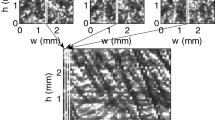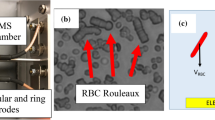Abstract
In order to clarify the mechanism of dextran-induced aggregation, the effect of the ionic strength (I) on the minimal shear stress (τ c ) required to rupture RBC doublets was studied for suspensions with the external media containing 76 and 298 kDa dextrans. At low and high ionic strengths, τ c increases with increasing I, whereas at intermediate I values, τ c versus I dependencies reveal a plateau step. The non-monotonous shape of these curves disagrees with the depletion model of RBC aggregation and is consistent with the predictions of the bridging mechanism. Literature reports point out that elastic behavior of dextran molecules in low and high I regions is fairly typical of Hookean springs and hence predict an increase in τ c with increasing I. A plateau step is accounted for by the enthalpic component of the dextran elasticity due to the shear-induced chair–boat transition of the dextran’s glucopyranose rings. A longer plateau step for suspensions with a higher molecular weight dextran is explained by a larger contribution of the enthalpic component to the dextran elasticity. Thus, the results reported in this study provide evidence that RBC aggregation is caused by the formation of dextran bridges between the cells.







Similar content being viewed by others
Notes
Since blood is a yield stress material (Yeow et al 2002), its true shear stress differs from the product of \(\eta \dot \gamma.\)
Since D250 was not available at our laboratory, it was assumed that eqs. 5 and 6 obtained for suspensions with D250 describe adequately the shear dependent viscosity of suspensions with D298 which were used to measure the effective steady-state radius of RBC aggregates at different shear rates. Note that literature reports point out that this difference of molecular weights does not measurably affect both RBC aggregation and blood viscosity (Armstrong et al, 2004).
References
Alvarez FJ, Herraez A, Tejedor MC, Diez JC (1996) Behavior of isolated rat and human red blood cells upon hypotonic-dialysis encapsulation of carbonic anhydrase and dextran. Biotechnol Appl Biochem 23:173–179
Armstrong JK, Wenby RB, Meiselman HJ, Fisher TC (2004) The hydrodynamic radii of macromolecules and their effect on red blood cell aggregation. Biophys J 87:4259–4270
Barshtein G, Tamir I, Yedgar S (1998) Red blood cell rouleaux formation in dextran solution: dependence on polymer conformation. Eur Biophys J 27:177–181
Baskurt OK, Tugral E, Neu B, Meiselman HJ (2002) Particle electrophoresis as a tool to understand the aggregation behavior of red blood cells. Electrophoresis 23:2103–2109
Bäumler H, Neu B, Iovtchev S, Budde A, Kiesewetter H, Latza R, Donath E (1999) Electroosmosis and polymer depletion layers near surface conducting particles are detectable by low frequency electrorotation. Colloids Surf A: Physicochem Eng Aspects 149:389–396
Bäumler H, Donath E, Krabi A, Budde A, Kiesewetter H (2001) Electrophoresis of human red blood cells and platelets. Evidence for depletion of dextran. Biorheology 33:333–351
Berezina TL, Sergey B, Zaets SB, Morgan C, Spillert CR (2002) Influence of storage on red blood cell rheological properties. J Surg Res 102:6–12
Brooks DE (1973a) The effect of neutral polymers on the electrokinetic potential of cells and other charged particles: II. A model for the effect of adsorbed polymer on the diffuse double layer. J Colloid Interface Sci 43:687–699
Brooks DE (1973b) The effect of neutral polymers on the electrokinetic potential of cells and other charged particles: III. Experimental studies on the dextran/erythrocyte system. J Colloid Interface Sci 43:700–713
Brooks DE (1973c) The effect of neutral polymers on the electrokinetic potential of cells and other charged particles: IV. Electrostatic effects in dextran-mediated cellular interactions. J Colloid Interface Sci 43:714–726
Brooks DE, Greig RG, Janzen J (1980) Mechanisms of erythrocyte aggregation. In: Cokelet GR, Meiselman HJ, Brooks DE (eds) Erythrocyte mechanics and blood flow. A.R. Liss, New York, pp 119–140
Chien S, Simchon S, Abbot RE, Jan K-M (1977) Surface adsorption of dextrans on human red cell membrane. J Colloid Interface Sci 62:461–470
Cicha I, Suzuki Y, Tateishi N, Shiba M, Muraoka M, Tadokoro K, Maeda N (2000) Gamma-ray-irradiated red blood cells stored in mannitol-adenine-phosphate medium: rheological evaluation and susceptibility to oxidative stress. Vox Sang 79:75–82
Cokelet GR (1999) Viscometric, in vitro and in vivo blood viscosity relationships: how are they related? Biorheology 36:343–358
Cudd A, Arvinte T, Schulz B, Nicolau C (1989) Dextran protection of erythrocytes from low-pH-induced hemolysis. FEBS Let 250:293–296
Derjaguin BV, Muller VM, Toporov YuP (1975) Effect of contact deformations on the adhesion of particles. J Colloid Interface Sci 53:314–326
Donath E, Voigt A (1986) Electrophoretic mobility of human erythrocytes. On the applicability of the charged layer model. Biophys J 49:493–499
Einstein A (1906) Eine neue bestimmung der molekul dimension. Ann Phys 19:289–306
Fåhraeus R (1929) The suspension stability of blood. Physiol Rev 9:241–274
Fisher TE, Marszalek PE, Oberhauser AF, Carrion-Vazquez M, Fernandez JM (1999) The micro-mechanics of single molecule studied with atomic force microscopy. J Physiol (Lond) 520:5–14
Fricke K, Wirthensohn K, Laxhuber R, Sackmann E (1986) Flicker spectroscopy of erythrocytes. A sensitive method to study subtle changes of membrane bending stiffness. Eur Biophys J 14:67–81
Godin C, Caprani A (1997) Effect of blood storage on erythrocyte/wall interactions: implications for surface charge and rigidity. Eur Biophys J 26:175–82
Goldsmith HL (1974) The microrheology of human erythrocyte suspensions. In Proceedings of the 13th International Congress on Theoretical and Applied Mechanics. Springer, Berlin, Heidelberg, New York, pp 85–103
Haydon DA, Seaman GV (1967) Electrokinetic studies on the ultrastructure of the human erythrocyte. I. Electrophoresis at high ionic strengths–the cell as a polyanion. Arch Biochem Biophys 122:126–136
Helfrich W (1978) Steric interaction of fluid membranes in multilayer systems. Z Natuforsch 33c:305–315
Hovav T, Yedgar S, Manny N, Barshtein G (1999) Alteration of red cell aggregability and shape during blood storage. Transfusion 39:277–81
Hsu J-P, Lin S-H, Tseng S (2003) Effect of cell membrane structure of human erythrocyte on its electrophoresis. Colloids Surf B: Biointerfaces 32:203–212
de Kerchove AJ, Elimelech M (2005) Relevance of electrokinetic theory for "soft" particles to bacterial cells: implications for bacterial adhesion. Langmuir 21:6462–6472
Krieger JM, Dougherty T (1959) A mechanism for non-Newtonian flow in suspensions of rigid spheres. Trans Soc Rheol 3:137–152
Levine S, Levine M, Sharp KA, Brooks DE (1983) Theory of the electrokinetic behavior of human erythrocytes. Biophys J 42:127–135
Li H, Rief M, Oesterhelt F, Glaub HE (1999) Force spectroscopy on single xanthan molecules. Appl Phys A 68:407–410
Maeda N, Seike M, Suzuki Y, Shiga T (1988) Effect of pH on the velocity of erythrocyte aggregation. Biorheology 25:25–30
Marszalek P, Oberhauser AF, Pang Y-P, Fernandez JM (1998) Polysaccharide elasticity governed by chair-boat transitions of the glucopyranose ring. Nature 396:661–664
Marszalek P, Li H, Oberhauser AF, Fernandez JM (2002) Chair-boat transitions in single polysaccharide molecules observed with force-ramp AFM. PNAS 99:4278–4283
Merrill EW, Benis AM, Gilliland ER, Sherwood TK, Salzman EW (1965) Pressure-flow relations of human blood in hollow fibers at low flow rates. J Appl Physiol 20:954–967
Mi XQ, Chen JY, Cen Y, Liang ZJ, Zhou LW (2004) A comparative study of 632.8 and 532 nm laser irradiation on some rheological factors in human blood in vitro. J Photochem Photobiol B 74:7–12
Neu B, Meiselman HJ (2002) Depletion-mediated red blood cell aggregation in polymer solutions. Biophys J 83:2482–2490
Neu B, Sowemimo-Coker SO, Meiselman HJ (2003) Cell-cell affinity of senescent human erythrocytes. Biophys J 85:75–84
Ohshima H (2000) On the general expression for the electrophoretic mobility of a soft particle. J Colloid Interface Sci 228:190–193
Pribush A, Meiselman HJ, Meyerstein D, Meyerstein N (1999) Dielectric approach to the investigation of erythrocyte aggregation: I. Experimental basis of the method. Biorheology 36:411–423
Pribush A, Meiselman HJ, Meyerstein D, Meyerstein N (2000) Dielectric approach to investigation of erythrocyte aggregation. II. Kinetics of erythrocyte aggregation-disaggregation in quiescent and flowing blood. Biorheology 37:429–441
Pribush A, Meyerstein D, Meyerstein N (2004a) Conductometric study of shear-dependent processes in red cell suspensions. I. Effect of red blood cell aggregate morphology on blood conductance. Biorheology 41:13–28
Pribush A, Meyerstein D, Meyerstein N (2004b) Conductometric study of shear-dependent processes in red cell suspensions. II. Transient cross-stream hematocrit distribution. Biorheology 41:29–43
Quemada D (1977) Rheology of concentrated disperse systems and minimum energy dissipation principle. I: Viscosity-concentration relation. Rheol Acta 16:82–94
Raat NJ, Verhoeven AJ, Mik EG, Gouwerok CW, Verhaar R, Goedhart PT, de Korte D, Ince C (2005) The effect of storage time of human red cells on intestinal microcirculatory oxygenation in a rat isovolemic exchange model. Crit Care Med 33:39–45
Rampling MW (1988) Red cell aggregation and yield stress. In: Lowe GDO (ed) Clinical Blood Rheology. CRC Press, Boca Raton, pp 45–64
Rief M, Oesterhelt F, Heyman B, Gaub H (1997) Single molecule force spectroscopy on polysaccharides by atomic force microscopy. Science 275:1295–1297
Rief M, Fernandez JM, Gaub HE (1998) Elastically coupled two-level systems as a model for biopolymer extensibility. Phys Rev Lett 81:4764–4767
Schwan HP (1963) Determination of biological impedances. In: Nastuk WL (ed) Physical techniques in biological research, vol. 6, Academic Press, New York, p 344
Snabre P, Bitbol M, Mills P (1987) Cell disaggregation behavior in shear flow. Biophys J 51:795–807
Snabre P, Haider L, Boynard M (2000) Ultrasound and light scattering from a suspension of reversible fractal clusters in shear flow. Eur Phys J E 1:41–53
Sonntag RC, Russel WB (1986) Structure and breakup of flocs subjected to fluid stresses: I. Shear experiments. J Colloid Interface Sci 113:399–413
Sonntag RC, Russel WB (1987) Structure and breakup of flocs subjected to fluid stresses: II. Theory. J Colloid Interface Sci 115:378–389
Starov VM, Zhdanov VG (2003) Viscosity of emulsions: influence of flocculation. J Colloid Interface Sci 258:404–414
Thurston GB (1972) Viscoelasticity of human blood. Biophys J 12:1205–1217
Yeow YL, Wickramasinghe SR, Leong YK, Han B (2002) Model-independent relationships between hematocrit, blood viscosity, and yield stress derived from Couette viscometry data. Biotechnol Prog 18:1068–1075
Acknowledgments
We wish to express our sincere gratitude to Prof. H. J. Meiselman from the University of Southern California (USA) for providing the shear viscosity data. This study was supported by a grant from the Israel Science Foundation, No. 457/02.
Author information
Authors and Affiliations
Corresponding author
Rights and permissions
About this article
Cite this article
Pribush, A., Zilberman-Kravits, D. & Meyerstein, N. The mechanism of the dextran-induced red blood cell aggregation. Eur Biophys J 36, 85–94 (2007). https://doi.org/10.1007/s00249-006-0107-1
Received:
Accepted:
Published:
Issue Date:
DOI: https://doi.org/10.1007/s00249-006-0107-1






